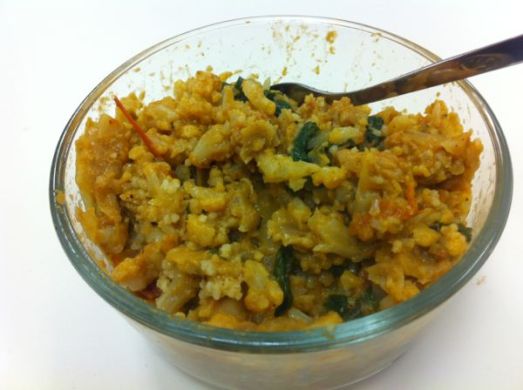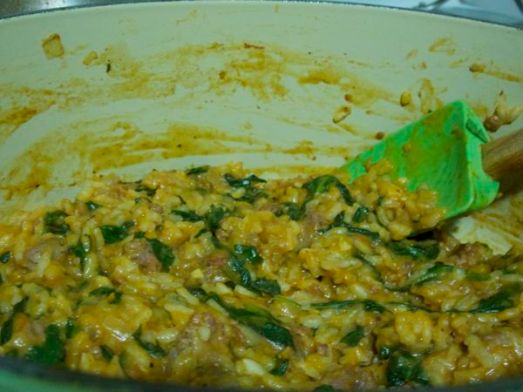Since, oh, 2005, I’ve been talking about organizing my clipped recipes. I started saving recipes — mostly from magazines like Real Simple and Health — when I first started living on my own, back in 2004, and every time I’ve had a significant break since then (the holidays in 2006, before grad school in 2009, and spring break 2011, among others), I’ve imagined sitting down with the big blue folder full of disorganized, grease-stained, piling-up recipes and sorting and culling and sense-making until they were actually useful.

And last week, I finally did it.

The exercise turned out to be a fascinating journey through my years in the kitchen. From 2004 and 2005, I had a ton of “heat and dump” recipes — things involving pre-cooked this and pre-shredded that. From 2005 and 2006, when I first started getting serious about making food instead of giving up and going to Taco Bell at midnight, I had a ton of chicken recipes — funny in light of my dislike of cooking chicken. At some point, maybe late 2006, I started to collect dessert recipes. And 2009 to the present brought more elaborate recipes — things from Food and Wine and the New York Times, things involving lamb and immersion blenders and more than 45 minutes in the kitchen. I found the wrinkled original of garden lasagna, the first recipe I felt truly comfortable making; I rediscovered old favorites like chicken/apple/basil salad and sausage with polenta cakes and my first attempt at corn chowder. And I found a few things that made me nostalgic, like recipes from Sassy (1996!) and Jane and lovely party plans from Budget Living. (I kept them all.)
I also found a lot of things — er, most of the recipes I’d saved — that I’d never made. I suppose that’s the hazard of collecting recipes and not having a system to look through them: The things I made regularly rose to the top, totally obscuring the vast stack of goodies underneath. So for the binder’s first real spin, I picked out one of those long-ago-saved, never-before-cooked recipes, a Thai ginger chicken dinner from Real Simple (2006!).

As I’ve mentioned before on this site, one of the things I want to do is become more comfortable trusting my instincts in the kitchen. I’ve come a long way since I first collected a lot of these recipes, but I still don’t always listen. This turned out to be one of the recipes where I should have trusted my instincts. Two cans of coconut milk seemed like a lot — like, a lot — and yet, it had been a while since I’d cooked with coconut milk and I wasn’t sure how much it would thicken up and besides, I wanted leftovers, didn’t I?
Well. Yes. But not liquid leftovers. One can would have been sufficient for sure.
I did make one good, fun tweak: I realized late in the game that I didn’t have any soy sauce, so I tossed in some Trader Joe’s sweet chili sauce instead. It added some more sweetness but wasn’t cloying (which I’d worried about considering the sheer quantity of coconut milk in the pan), and I added some extra salt to compensate.
The best part of this recipe, for me, was the puree of hot pepper, cilantro, and ginger that got added to the simmering pot. Chopping less, eating sooner? Works for me.
What’s below is the version of this recipe I wish I’d made. My dinner was fine, but I think this’ll be even better.
Spicy Ginger Chicken
(Adapted from Real Simple
Ingredients
1 lb. chicken breasts, cut into bite-sized pieces
1 onion, sliced
1 small eggplant, cut into 1- to 2-inch pieces
1 13.5 oz. can coconut milk or light coconut milk
2 Tablespoons chili sauce, soy sauce, or spicy addition of your choice
2-3 jalapenos or other hot peppers, seeded and roughly chopped
a few sprigs of cilantro, roughly chopped
1 2-inch piece of ginger, peeled and roughly chopped
olive oil
salt
rice of your choice, if desired
Instructions
1. Cook the rice, if using. (Side note: I used basmati, because it was all we had in the house, and I followed a suggestion I saw online to soak it in cold water first, and wow, it came out bright white.)
2. Chop the eggplant, place in a bowl, and salt generously. Let sit for 15 minutes while you chop everything else, then drain, rinse, and pat dry.
3. Heat olive oil in a large saucepan over medium heat. Cook the onion and the eggplant until soft, about 5 minutes.
4. While that’s cooking, put the cilantro, ginger, and hot peppers in a food processor with some olive oil and give them a couple of whirls until they’re finely chopped.
5. Add coconut milk, chili/soy sauce, and some salt to the saucepan and bring to a simmer. Add the cilantro mixture and chicken pieces and simmer until the chicken is cooked through.







